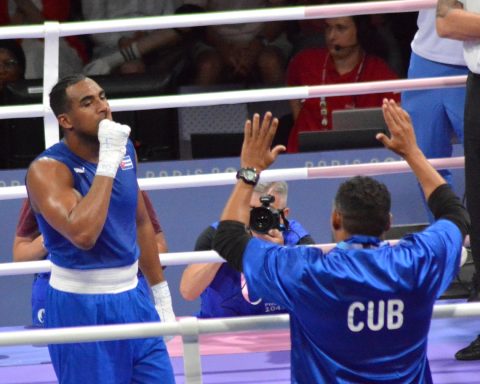Havana Cuba. — It is terrifying when they begin to die, octogenarians, the divas that one enjoyed in adolescence. It happens to me with Tina Turner, one of the greatest singers of rock and rhythm and blueswinner of nine Grammy Awards, who just passed away at the age of 83s in Switzerland, where he lived his last times.
It was never easy for me to assimilate that with the figure she maintained she was called “the grandmother of rock”. The first time I saw Tina, accompanied by three showgirls just as stunning as she was, her husband Ike Turner, and the band she led, singing her version of Proud Maryit was in a video taken from an Italian television program in the second half of the 70s, when the commissioners who ensured our ideological purity began to allow us to listen to Anglo-Saxon music.
By the time I saw the video, which dated from 1971—everything arrived late in Cuba—Ike and Tina Turner had already separated. It would be several years before Tina Turner reinvented herself and, with a new looks and singing the same as before or better, he will return to definitely achieve international success with songs like What’s love got to do, your version from Let’s stay together by Al Green, and private dancercomposed especially for her by Mark Knoffler.
Tina Turner was a forerunner of me too when denouncing the abuses to which she was subjected by her husband. Both in her autobiography, I, Tina: My life history, like in the movie about his life, What’s love got to do with it (1993) —directed by Brian Gibson and starring Angela Basset and Lawrence Fishburne—, Ike Turner, who was her husband for fifteen years and died in 2007 of a cocaine overdose, is depicted as a misogynist, abuser, macho, vicious and depraved, while they show Tina candid and long-suffering, in her role as a full-time victim, who did not drink or smoke and who ends up looking for her path, without renouncing Christ, in Zen Buddhism.
Tina Turner recounted that in Nutbush, Tennessee, where she was born in 1939, she was raised as a Baptist in a puritanical and virtuous environment. But she, exquisitely cynical, tells how she lost her virginity before she was 15 years old “…after “a lot of kissing and groping, in the back seat of a car, it was the 50s, right?”
He explained in the book how his artistic persona was created by Ike Turner, who by turning Anne Mae Bullock (her real name) into Tina, the singer of his group, freed her from the job as a cotton picker that she hated so much: “When I was As a boy, back in Clarksdale, Mississippi, Ike had become obsessed with the white goddess of the jungle from the Saturday matinee film serials, which featured women in rags with long flowing hair and names like Sheena and above all, Nyoka. . he still remembered The dangers of Nyoka, a fifteen-part 1941 Republic Pictures serial starring Kay Alridge as Nyoka, featuring a villain named Vultura, a monkey named Satan, and Clayton Moore, later the Lone Ranger from TV. Nyoka, Sheena, Tina, Ike’s Wild Woman! He liked that!”
Free of Ike, Tina made her triumphant return, carrying with her, slightly modified, the wild image he had fashioned. That has been widely criticized, even to the extent of her exaggeration, by feminists like Gloria Watkins (better known by the pseudonym bell hooks, so with lower case letters), who she has written in the rehearsal Selling hot pussy. Representations of black female sexuality in the cultural marketplace: “Despite her experience of abuse rooted in sexist and racist objectification, Turner appropriated the image of the wild woman for her career. Always fascinated with wigs and long hair, she created the blonde lioness mane to appear more wild and animalistic. Her blonde status ties her to images of the jungle, while she endorses a racist aesthetic that sees blonde hair as the epitome of beauty. Without Ike, Turner’s career has soared to new heights, especially as she works harder to exploit the visual representation of black women as sexual savages. No longer caught up in the sadomasochistic sexual iconography of the black woman at erotic war with her partner, which was the subtext of Ike and Tina, she is now represented as the autonomous black woman, whose sexuality is a way of exercising power.” .
On the role of Aunt Entity, which Tina Turner played in the film Mad Max: beyond the thunderdome (1985), the hyper-sensitive feminist academic opined: “It evokes two racist-sexist stereotypes, that of the black mommy who has become avid for power and that of the sexual savage who uses her body to seduce and conquer men. Represented as eager for relationships with the white male hero who will win her over and reject her, Aunty Entity is the contemporary re-enactment of that mythical black slave who was supposed to cajole and seduce virtuous white masters. But the white male hero in Mad Max she is stronger than her colonial ancestors, and she does not succumb to the dangerous allure of the black seductress who rules a mini-nation whose power is based on the use of shit.”
Probably, Tina Turner, who as much as the feminists who attack her was the product of a patriarchal, sexist society and in which racial stereotypes persist, was not even aware of the implications of that image that criticized her and that she took so much advantage of in her life. his successful artistic career.
OPINION ARTICLE
The opinions expressed in this article are the sole responsibility of the person who issues them and do not necessarily represent the opinion of CubaNet.















